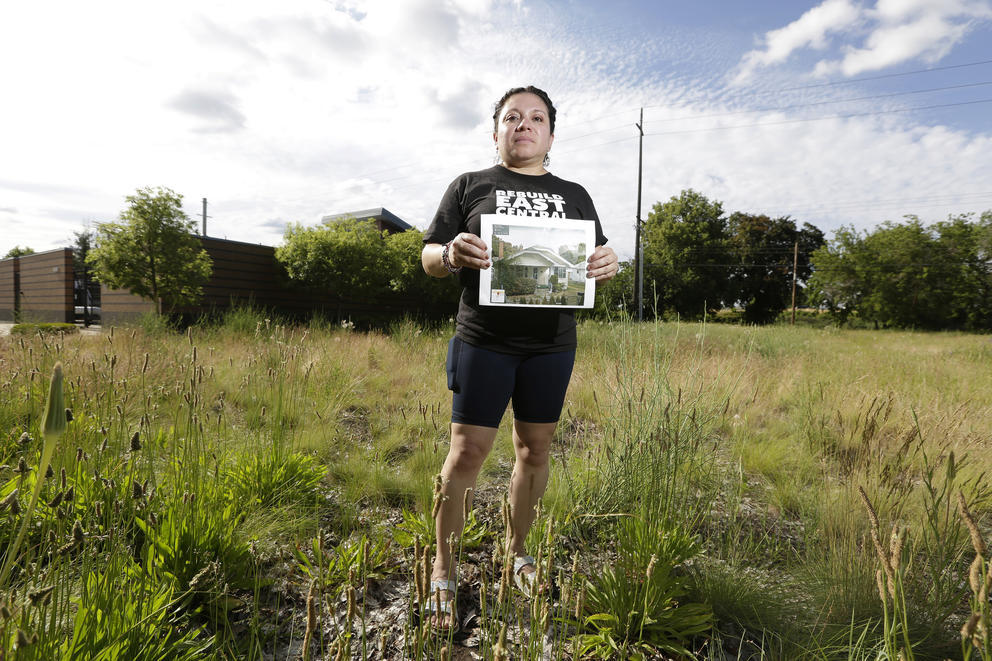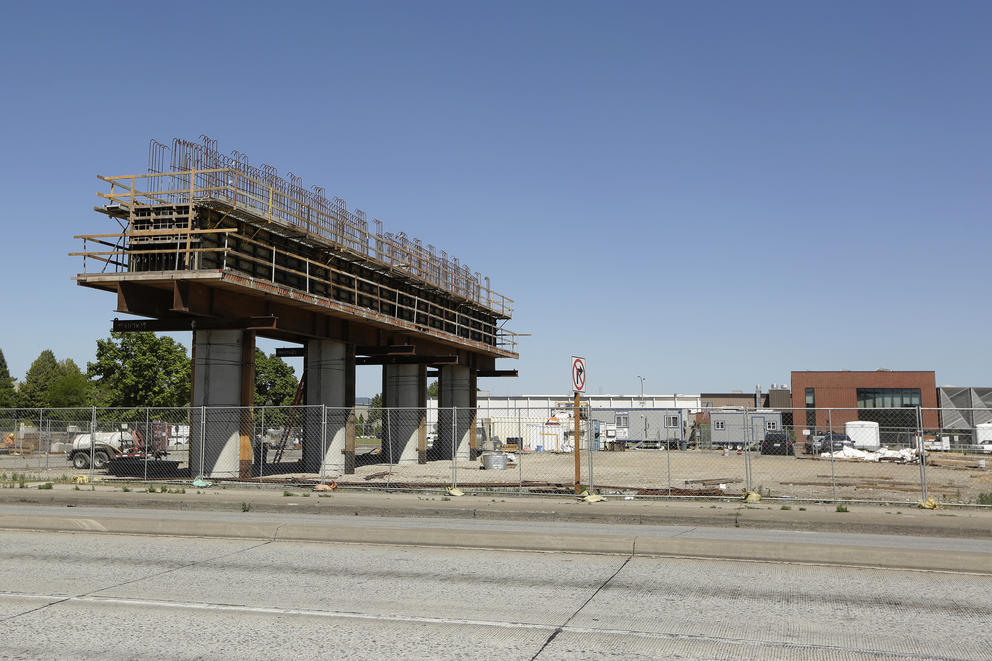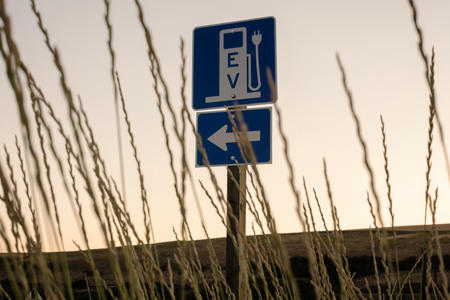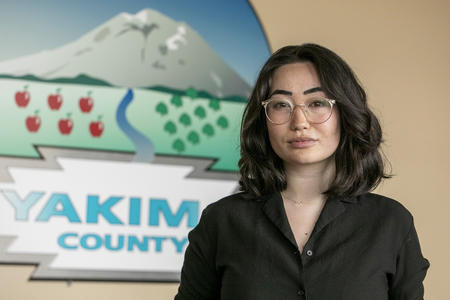Navarrete pulled up a picture on her phone of the two-story yellow craftsman bungalow that once sat here, the house she grew up in. Her father, she remembers, put in a chain-link fence and asphalt driveway himself. For Navarrete’s parents, who brought her to the U.S. from Mexico City in the late 1980s, homeownership was a point of pride.
“This house was everything to us,” Navarrete said. “Our first home, our American dream.”
Navarrete recalled dinners spent staring out the kitchen window at cars roaring past, listening to the sound of ambulances responding to crashes on the freeway. Despite the noise, she remembers it as a pleasant, tight-knit community. She gestured across the street, where a row of houses remains undisturbed, at the home her cousin once lived in, and at the house of the family she babysat for.
“When it was full of houses, we used to walk the same street down to go to the pool at Liberty Park,” she said. “Seeing people mowing their lawns, watering their lawns, working in their yard … and now it’s weeds and all empty.”
Like many communities of color across the country, East Central – one of Spokane’s most diverse neighborhoods, and a hub for Black culture in an overwhelmingly white city – has paid a high price for the region's car-centric vision of economic development.
Crews razed the Navarrete home and more than 600 other buildings in recent years to make room for an interchange serving a long-awaited north-south freeway, reopening historical wounds from when the east-west I-90 punched through in the 1960s and similarly displaced thousands of residents.
As the state works to direct billions in federal recovery dollars into infrastructure projects, transportation officials say they recognize the disproportionate harm linked to past development and hope to mitigate future impacts. But environmental justice advocates argue the latest $17 billion Move Ahead WA transportation spending package — while a step forward in many ways — still contains billions for short-sighted and regressive highway projects.
Democratic lawmakers maintain infrastructure spending has moved closer to people- and environment-friendly priorities. And a pilot program in Spokane will also offer excess property from the new freeway for community development, such as affordable housing or parks.
“We envisioned this as a pivot point where we begin intentionally heading in a new direction,” said Washington state Sen. Marko Liias, chair of the Senate Transportation Committee. “Our success should be measured in how effectively we’re shifting the conversation.”
Interstate 90 first cut through the diverse East Central neighborhood in the 1960s, displacing thousands of residents and most of Liberty Park. As the North Spokane Corridor freeway moves to again split through the community, residents want to focus on protecting what makes the area special. (Madeleine Pisaneschi/Crosscut)
Remaking a community
Just a handful of blocks away from Navarrete’s childhood home is Fifth Avenue, once the commercial center of what residents recall as a thriving Black business district. When I-90 came through in the 1960s, it cut off Fifth Avenue from the rest of East Central, a larger area that extends north to the rebounding Sprague Avenue business district that now sports new boutiques, bakeries and apartment buildings.
In recent years, there’s been a resurgence of development along Fifth Avenue, driven by a Black-owned soul food restaurant and the Carl Maxey Center, a community meeting space spearheaded by Sandy Williams, publisher of the Black Lens newspaper.
Williams described feeling hyper visible growing up in white, homogenous Spokane. East Central often served as the “only thing that felt like home.” On a recent drive around the neighborhood, she pointed out places that make it special, despite its challenges: the under-appreciated Underhill Park, a new dental clinic, a new library located at Liberty Park. (Once the city’s largest park, 19 of its original 21 acres were lost to I-90.)
Despite some abiding skepticism, Williams said the new pilot program to repurpose the state’s surplus Department of Transportation property in East Central for community use could serve as a transformative asset for a neighborhood repeatedly dealt a losing hand.
“Is it true that there’s a system in place that ensures that if there’s a highway going to be built, that it goes through low-income neighborhoods? I think there is,” said Williams. “But … I’m going to do my damndest to make sure that this community, this neighborhood, has a say in what happens to that land.”
This story is a part of Crosscut’s WA Recovery Watch, an investigative project tracking federal dollars in Washington state.
The North Spokane Corridor was first proposed in the 1950s. Previous iterations would have routed it through the Logan neighborhood near Gonzaga. In 1997, an environmental impact statement identified the current route as the state’s preferred option.
Although it’s been in the works for decades and began construction in 2001, the $1.5 billion project has experienced ongoing funding delays and was fully funded only in 2015.
Gonzaga University philosophy professor Brian Henning said the long lifespan of the project has slowly muted opposition, making the highway seem like simply a fact of life.
“Sometimes when something has just been in the context for so very, very long that even [for] those who would have resisted it, it’s now part of fabric, part of the background, it’s inevitable at this point,” said Henning, who founded the university’s Center for Climate, Society, and the Environment.
In addition to the bifurcation of neighbors and businesses, Henning said communities like East Central also often have the least power to resist big infrastructure projects, and the least resources to respond to the air quality, carbon emissions and other environmental problems exacerbated by new highways.
“In particular poor people and people of color, they created the least of the problem [and] have the smallest carbon footprint because they don’t have a lot of resources…but they bear a disproportionate burden of the effects,” Henning said.
This idea, often referred to as environmental justice, is key to the burgeoning anti-highway movement, which also includes residents of the majority-Hispanic South Park neighborhood in South Seattle, who are advocating for the removal of a portion of State Highway 99. Such causes have elevated the climate and health costs of a transportation system dominated by cars, the country’s leading source of greenhouse gas emissions.
In response to a request to speak with senior officials about how projects get prioritized, a WSDOT spokesperson deflected questions to legislators who set transportation budgets.
But Mike Gribner, WSDOT’s East Regional director, defended the rationale for the highway, saying it would remove long-haul truck traffic from Division Street, the city’s current north-south thoroughfare. Nearly as wide as a highway in some places, but with many stoplights and frequent congestion, Division Street is also the primary route for long-haul freight to and from Canada.
“The net benefits exceed the impacts,” Gribner said. “How Division Street is going to develop and the land use around that in the downtown core, and how transit can be utilized on that corridor is really only available to this discussion if we move the regional [truck] trips off this system.”
Gribner also argued the highway will have environmental benefits because it will move vehicles faster, reducing congestion and idling. But transportation experts largely agree that new highways quickly fill up with cars, reversing any effect on congestion and ultimately leading to more driving and emissions, an outcome commonly referred to as “induced demand.” Asked about this phenomenon, Gribner remained vague on whether he would expect an increase in overall car usage.
“I’m not certain whether this does create trips or not,” Gribner said. “But efficiency generally creates trips, so I think it’s certainly conceivable that the North Spokane Corridor is going to create trips just because the system is more efficient.”
Washington state Sen. Andy Billig, the Democratic majority leader who represents Spokane, helped lead efforts to secure funding to finish the north-south freeway, which was half-built when he entered the Legislature in 2011. Billig also linked completion of the highway to a revamped, more pedestrian and transit-friendly Division Street.
Some city leaders envision a future bus rapid transit line opening in 2029, with buses coming every 10 minutes in a dedicated lane. The state Legislature put aside $50 million for that project in the recent transportation funding package.
“I understand the sentiment that freeways like this are a vision of the past, I get that, and I don’t completely disagree with that,” Billig said. “But I also know that a modern, transit-oriented, efficient vision for a corridor like Division [Street] is not possible without the North Spokane Corridor.”
A highway-driven culture
In the years following the construction of I-90, Spokane lost 11,000 residents as people increasingly decamped for the suburbs. Although the city regained residents and eventually surpassed its previous population by the 1990s, it has lagged far behind the county as a whole.
According to Spokane architect William Grimes, that’s in part because two things happened: The city added land area and became less dense, with growth concentrating on the suburban fringes newly accessible via the freeway.
“Spokane chose to allow the expanded urban settlement of the east-west corridor, creating new, intensely urban communities,” Grimes wrote in an academic article titled Learning from I-90: The North-South Freeway’s Implications for Urban Form. Those new suburban developments, Grimes wrote, “compet[ed] directly with the central city for resources and creat[ed] an overall decrease in population density despite population growth.”
A similar phenomenon could play out with the north-south freeway enabling suburban sprawl to extend northeast of the city, Grimes wrote. As with I-90, it has the potential to weaken the city’s ability to draw new residents and investment.
While the North Spokane Corridor is a done deal, a larger battle over the impact and future of transportation continues in the state Legislature. Lawmakers in March approved the Move Ahead WA transportation funding package, which allocates $17 billion over the next 16 years.
Senate budget writers hailed the package as a transformative shift from past highway-centric packages toward a more multimodal future. Compared to the 2015 “Connecting Washington” transportation funding package, which directed just 6% of funds to public transit and bicycle/pedestrian projects, Move Ahead WA invested 25% in those areas, according to a presentation by the Washington State Transit Association.
Still, it included more than $3 billion for expanding highways.
The package includes a 9-mile extension of highways 509 and 167, known collectively as the Puget Sound Gateway, and $1 billion for an overhaul of the Washington-Oregon I-5 bridge that could stretch the roadways to add lanes. It also would spend a combined $820 million to widen sections of I-90 and State Route 18 through the Cascades.
Paulo Nunes-Ueno, an organizer with the BIPOC-led Front and Centered coalition, praised the new money for active transportation projects, but wrote in a statement that the highway expansion funding “represents a severe failure to take climate and environmental justice seriously.” A Front and Centered analysis of the highway projects funded by Move Ahead WA concluded that 177 miles of new highway lanes would add between 600 million and 900 million vehicle miles traveled by 2050.
“Investments in highways are investments in fossil fuel infrastructure,” Nunes-Ueno said.
With the $1 trillion Infrastructure Jobs and Investment Act (IIJA) – commonly called the bipartisan infrastructure law – hitting states’ coffers this year, some climate experts warn that those investments could actually worsen climate change if spent on highway expansion.
State lawmakers took about $3.7 billion of federal dollars from the infrastructure bill to fund Move Ahead WA.
In major cities across the country, many local leaders have determined that urban freeways no longer suit residents' needs. According to the Congress for New Urbanism, 18 U.S. cities have replaced highways with leaner, more accessible streets, including Rochester, San Francisco and even Detroit. More recently, planned highway expansion projects were called off in Los Angeles and Denver.
Liias, chair of the Senate Transportation Committee, defended the highway expansion funds in Move Ahead WA, saying they were either needed for safety (State Route 18), finishing projects that were approved by previous packages (Puget Sound Gateway), or adding HOV lanes to I-5, which he does not view as a highway expansion.
Liias added that he approaches new highway proposals with more scrutiny than past leadership has, and that Move Ahead WA includes new “screening mechanisms and data-driven processes” to measure things like induced demand when new highways are proposed.
“Those are questions the department [of transportation] hasn’t been asked in the past,” Liias said. “We’re changing a culture around transportation that’s existed in this state since the 1950s, and that doesn’t happen overnight.”
Vehicles on I-90 pass vacant land seen from a pedestrian bridge near S. Regal St., Monday, July 11, 2022, in Spokane, Wash. The Washington State Department of Transportation purchased and demolished homes for construction of the North Spokane Corridor interchange, but no longer needs a significant amount of the property. (Young Kwak for Crosscut)
Stitching the neighborhood back together
In the years since Navarrete’s block was torn down, the DOT land has sat vacant. On the north side of I-90, one square block is now occupied by a homeless encampment with more than 600 inhabitants. The residents of that camp are expected to be displaced soon, as the city moves forward with a state-funded plan to sweep the camp and move residents into new shelters.
In the 2022 legislative session, Billig passed a bill directing WSDOT to make some of the surplus vacant land available to the community. He cast it as an effort to reckon with some of the historical damage done to East Central by both highways.
Gribner of WSDOT said plans for the vacant land are still in early stages. WSDOT provided maps of the potentially available land, but stressed that the boundaries could change as the final structure of the highway has not yet been determined.
The state Legislature also allocated $4 million for design of a pedestrian bridge over I-90. In response to community requests, WSDOT also applied for a federal grant for the “land bridge” proposal.
Currently there are few places to cross I-90: several underpasses, and a few austere pedestrian bridges. Traversing those narrow concrete spans can be a dizzying experience, with the deafening sound of eighteen-wheelers criss-crossing below.
Find tools and resources in Crosscut’s Follow the Funds guide to track down federal recovery spending in your community.
The idea is similar to the “reconnecting communities” grant program recently launched by the U.S. Department of Transportation, a $1 billion effort funded by the infrastructure bill aimed at repairing neighborhoods like East Central. That program, which opened for applications in July, can fund things like pedestrian bridges, park lids and even removing highways.
“We can’t right every wrong that was done related to the placement of the freeway, but there is a lot we can do,” Billig told Crosscut. “I think this is just the start.”
The future of East Central
Community advocate Luc Jasmin III works with a group called Rebuild East Central, which coalesced around shaping the future of the vacant DOT land. The group plans to hire a consultant to help articulate the community’s vision for the property. Affordable housing is one element that many community members have stressed, along with parks and other public facilities.
Williams, of the Carl Maxey Center, offers one possible vision, turning her car up a steep hill toward the South Perry District. Technically part of East Central, new investment has spawned breweries, vintage stores and outdoor dining.
“This is what we want,” Williams said. “And affordable housing.”
With the DOT property, Jasmin III and Williams see a rare opportunity for the neighborhood to have a genuine say in its future – unlike with most decisions made in the past. They could help create a place where people like Navarrete – who now owns a home in East Central just a few blocks from where she grew up – can keep building on their American dreams.
As the suburbs around Spokane continue to grow – aided by the ability to drive quickly in and out from the city center – the region is likely to again face the question of whether to keep adding new vehicle lanes, or try something different.
A true reckoning with the past damage done by highways would involve making different choices in the future, said Henning, the climate ethics professor. One concrete step: repeal the 18th Amendment to the state constitution – which requires that gas tax revenue be used exclusively on roads and not public transit.
“We’re doing this and it’s going to happen and everybody’s resigned, but can we make this the last time?” Henning asked. “At some point we have to be trying to have these difficult conversations rather than thinking we’ll get different results with the same actions over and over again.”
Local leaders hope the billions of incoming federal infrastructure dollars will be used to bolster marginalized communities rather than upend them. Jasmin III is skeptical. He said he feels WSDOT has yet to engage meaningfully with Rebuild East Central or non-English speaking community members.
Avoiding the harms of the past will take more than surveys and the occasional listening session, he said – officials will have to challenge their old assumptions and treat community members like full partners.
“When you talk to them, what’s the general thought? We solved it already,” Jasmin III said, cracking a frustrated smile. East Central would look much different if that were the case.
“Success,” he said, “is different outcomes.”











